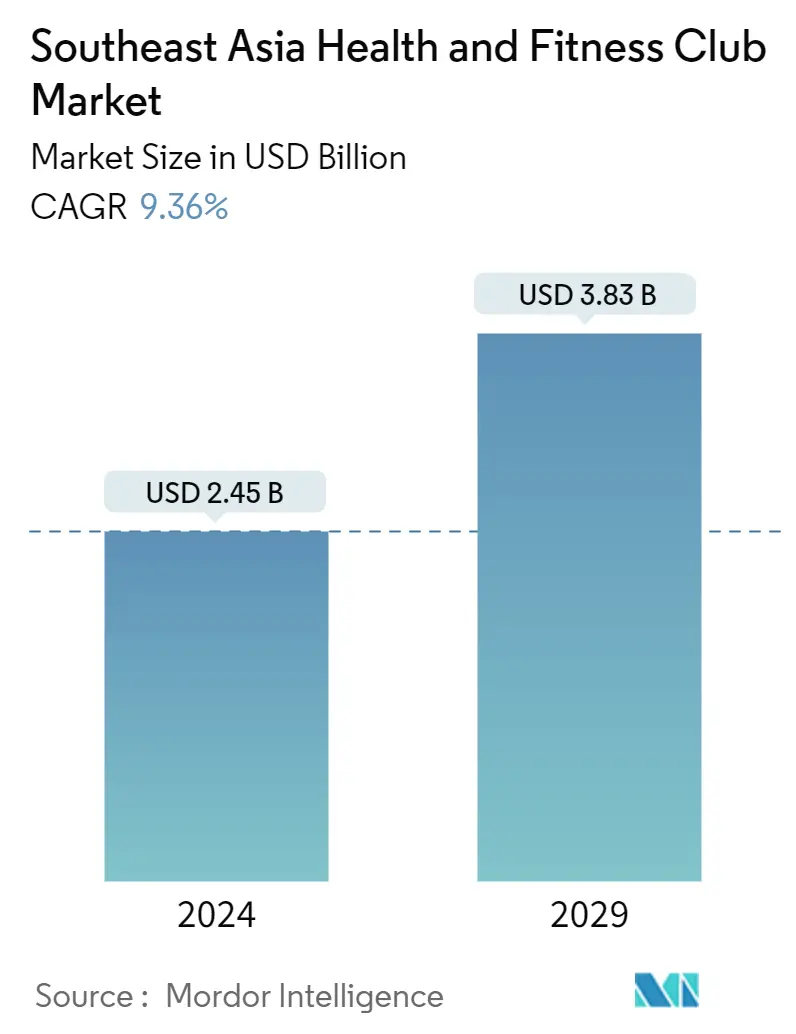Market Size of Southeast Asia Health And Fitness Club Industry

| Study Period | 2019-2029 |
| Base Year For Estimation | 2023 |
| Market Size (2024) | USD 2.45 Billion |
| Market Size (2029) | USD 3.83 Billion |
| CAGR (2024 - 2029) | 9.36 % |
| Market Concentration | Low |
Major Players.webp)
*Disclaimer: Major Players sorted in no particular order |
Southeast Asia Health And Fitness Club Market Analysis
The Southeast Asia Health And Fitness Club Market size is estimated at USD 2.45 billion in 2024, and is expected to reach USD 3.83 billion by 2029, growing at a CAGR of 9.36% during the forecast period (2024-2029).
Consumers increasingly engage in rigorous physical workouts that aid in weight control, boost stamina, and improve overall health. The rising number of health clubs and gyms with personal training, the latest fitness equipment, and rising health consciousness encourage individuals to indulge in workouts, impacting the market growth positively. Key players are launching facility spaces with yoga studios, high-altitude training rooms, and medical exercise areas to gain the attention of fitness enthusiasts. For instance, in May 2023, Anytime Fitness launched Les Mills classes and opened a new club in Malaysia. The new fitness club provides state-of-the-art equipment, expert trainers, and spacious workout areas to help achieve fitness goals.
With increasing disposable income, customers are willing to pay more for the convenience of higher-end fitness facilities. Therefore, players in the market are focused on launching luxury fitness clubs to meet customer needs. For instance, in October 2023, Kinetix Plus launched a luxury Boutique Gym in Makati, Philippines, which has fitness, training, relaxation, socializing, and recovery facilities. The members can sign up for PHP 800 monthly per the club’s statement.
Southeast Asia Health And Fitness Club Industry Segmentation
A health club is a facility center with exercise equipment for physical activities. It may be a for-profit commercial facility or a community- or institutionally-supported center. Such facilities accommodate professional athletes and casual members. The Southeast Asian health and fitness club market is segmented by service type (membership fees, personal training and instruction services, and other service types), outlet (chained and independent), and geography (Singapore, Malaysia, Thailand, Indonesia, Philippines, Vietnam, and Rest of Southeast Asia). The market sizing is in USD for all the abovementioned segments.
| By Service Type | |
| Membership Fees | |
| Personal Training and Instruction Services | |
| Other Service Types |
| By Outlet | |
| Chained Outlet | |
| Independent Outlet |
| By Geography | |
| Singapore | |
| Malaysia | |
| Thailand | |
| Indonesia | |
| Philippines | |
| Vietnam | |
| Rest of Southeast Asia |
Southeast Asia Health And Fitness Club Market Size Summary
The Southeast Asia health and fitness club market is experiencing significant growth, driven by an increasing consumer focus on health and wellness. This trend is supported by the proliferation of health clubs and gyms offering advanced fitness equipment and personal training services. The market is characterized by the introduction of innovative facilities such as yoga studios and high-altitude training rooms, which cater to the growing demand for diverse workout options. Key industry players are expanding their offerings to include luxury fitness clubs, reflecting the rising disposable incomes and willingness of consumers to invest in premium fitness experiences. This shift is further bolstered by the recognition of preventive health measures as essential, prompting individuals to incorporate structured workout routines into their lifestyles.
The competitive landscape of the Southeast Asian health and fitness club market features a mix of domestic and international players, all vying to meet the increasing demand for quality fitness services. Companies are focusing on expanding their presence and enhancing their service offerings to attract a broader customer base. The market is also witnessing investments in transforming fitness clubs into holistic wellness centers, equipped with state-of-the-art equipment and specialized programs. This growth is supported by rising awareness of the importance of a healthy lifestyle, increased healthcare spending, and initiatives promoting physical activity, which collectively contribute to the market's robust expansion.
Southeast Asia Health And Fitness Club Market Size - Table of Contents
-
1. MARKET DYNAMICS
-
1.1 Drivers
-
1.1.1 Inclination Toward Healthy Lifestyle
-
1.1.2 Strategic Expansion by Health & Fitness Clubs
-
-
1.2 Restraints
-
1.2.1 Rise in Popularity of Outdoor Activities
-
-
1.3 Industry Attractiveness - Porter’s Five Forces Analysis
-
1.3.1 Bargaining Power of Suppliers
-
1.3.2 Bargaining Power of Buyers
-
1.3.3 Threat of New Entrants
-
1.3.4 Threat of Substitute Products
-
1.3.5 Intensity of Competitive Rivalry
-
-
-
2. MARKET SEGMENTATION
-
2.1 By Service Type
-
2.1.1 Membership Fees
-
2.1.2 Personal Training and Instruction Services
-
2.1.3 Other Service Types
-
-
2.2 By Outlet
-
2.2.1 Chained Outlet
-
2.2.2 Independent Outlet
-
-
2.3 By Geography
-
2.3.1 Singapore
-
2.3.2 Malaysia
-
2.3.3 Thailand
-
2.3.4 Indonesia
-
2.3.5 Philippines
-
2.3.6 Vietnam
-
2.3.7 Rest of Southeast Asia
-
-
Southeast Asia Health And Fitness Club Market Size FAQs
How big is the Southeast Asia Health And Fitness Club Market?
The Southeast Asia Health And Fitness Club Market size is expected to reach USD 2.45 billion in 2024 and grow at a CAGR of 9.36% to reach USD 3.83 billion by 2029.
What is the current Southeast Asia Health And Fitness Club Market size?
In 2024, the Southeast Asia Health And Fitness Club Market size is expected to reach USD 2.45 billion.

